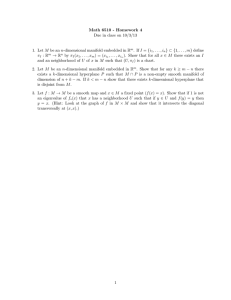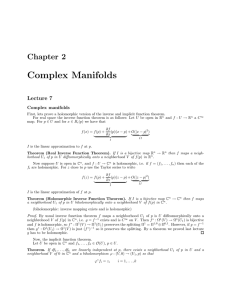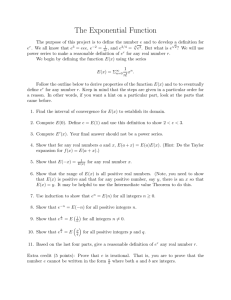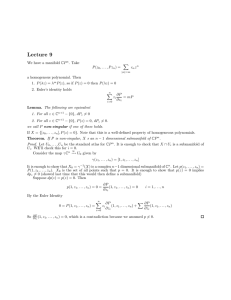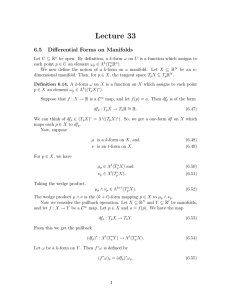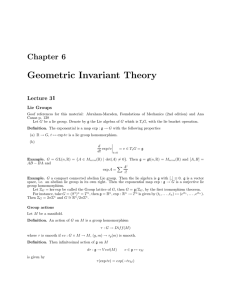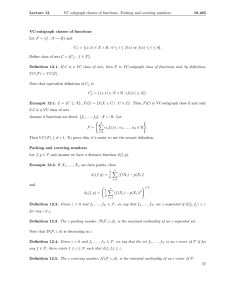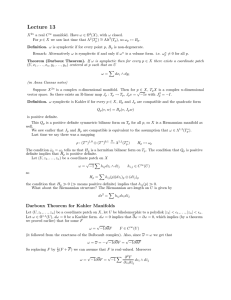Lecture 8
advertisement
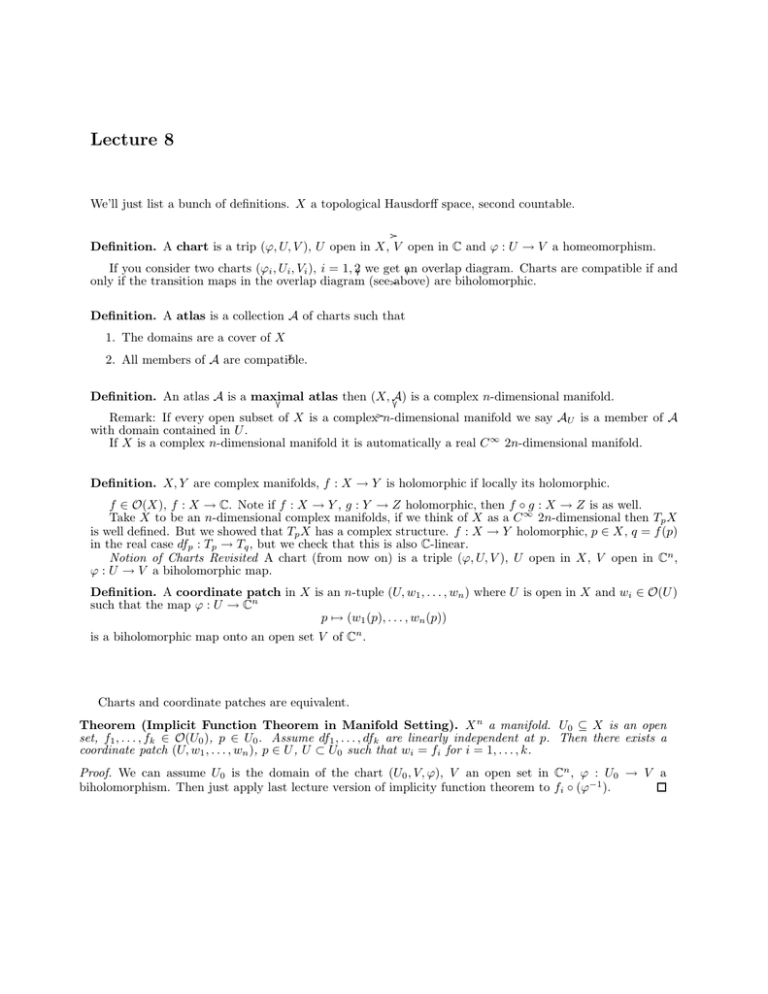
Lecture 8
We’ll just list a bunch of definitions. X a topological Hausdorff space, second countable.
�
Definition. A chart is a trip (ϕ, U, V ), U open in X, V open in C and ϕ : U → V a homeomorphism.
If you consider two charts (ϕi , Ui , Vi ), i = 1, 2� we get an
� overlap diagram. Charts are compatible if and
�
only if the transition maps in the overlap diagram (see above)
are biholomorphic.
Definition. A atlas is a collection A of charts such that
1. The domains are a cover of X
�
2. All members of A are compatible.
�
�
Definition. An atlas A is a maximal atlas then (X, A) is a complex n-dimensional manifold.
�
�
�
Remark: If every open subset of X is a complex n-dimensional
manifold we say AU is a member of A
with domain contained in U .
If X is a complex n-dimensional manifold it is automatically a real C ∞ 2n-dimensional manifold.
Definition. X, Y are complex manifolds, f : X → Y is holomorphic if locally its holomorphic.
f ∈ O(X), f : X → C. Note if f : X → Y , g : Y → Z holomorphic, then f ◦ g : X → Z is as well.
Take X to be an n-dimensional complex manifolds, if we think of X as a C ∞ 2n-dimensional then Tp X
is well defined. But we showed that Tp X has a complex structure. f : X → Y holomorphic, p ∈ X, q = f (p)
in the real case dfp : Tp → Tq , but we check that this is also C-linear.
Notion of Charts Revisited A chart (from now on) is a triple (ϕ, U, V ), U open in X, V open in Cn ,
ϕ : U → V a biholomorphic map.
Definition. A coordinate patch in X is an n-tuple (U, w1 , . . . , wn ) where U is open in X and wi ∈ O(U )
such that the map ϕ : U → Cn
p 7→ (w1 (p), . . . , wn (p))
is a biholomorphic map onto an open set V of Cn .
Charts and coordinate patches are equivalent.
Theorem (Implicit Function Theorem in Manifold Setting). X n a manifold. U0 ⊆ X is an open
set, f1 , . . . , fk ∈ O(U0 ), p ∈ U0 . Assume df1 , . . . , dfk are linearly independent at p. Then there exists a
coordinate patch (U, w1 , . . . , wn ), p ∈ U , U ⊂ U0 such that wi = fi for i = 1, . . . , k.
Proof. We can assume U0 is the domain of the chart (U0 , V, ϕ), V an open set in Cn , ϕ : U0 → V a
biholomorphism. Then just apply last lecture version of implicity function theorem to fi ◦ (ϕ−1 ).
Submanifolds
X a complex n-dimensional manfiolds. Y ⊂ X a subset.
Definition. Y is a k-dimensional submanifold of X if for every p ∈ Y there exists a coordinate patch
(U, z1 , . . . , zn ) with p ∈ U such that Y ∩ U is defined by the equation zk+1 = · · · = zn = 0.
Remarks: A k dimensional submanifold of X is a k-dimensional complex manifold in its own right.
Call a coordinate patch with the property above an adapted coordinated for X. The collection of
(n + 1)-tuples (U ′ , z1′ , . . . , zk′ ), (U, z1 , . . . , zn ), U ′ = U ∩ Y , zi′ = zi |U ′ gives an atlas for X.
By the implicit function theorem this definition is equivalent to the following weaker definition.
Definition. Y is a k-dimensional submanifold X if for every p ∈ Y there exists an open set U of p in X
and fi ∈ O(U ) where i = 1, . . . , l, l = n − k such that df1 , . . . , dfl are linearly independent at p and Y ∩ U ,
f1 = · · · = fl = 0, i.e. locally Y is cut-out by l independent equation.
Examples
Affine non-singular algebraic varieties in Cn . These are X-dimensional submanifolds, Y of Cn such
that for every p ∈ Y the fi ’s figuring into the equation above (the ones that cut-out the manifold) are
polynomials.
Projective counterparts We start by constructing the projective space CP n . Start with Cn+1 − {0}.
Given 2 (n + 1)-tuples we say
(z0 , z1 , . . . , zn ) ∼ (z0′ , z1′ , . . . , zn′ )
in Cn − {0} if there exists λ ∈ C − {0} with zi′ = λzi , i = 0, . . . , n. [z0 , z1 , . . . , zn ] are equivalence classes.
We define CP n to be these equivalence classes Cn+1 − {0}/ ∼.
We make this into a topological space by π : C n+1 − {0} → CP n , which is given by
(z0 , z1 , . . . , zn ) ∼ [z0 , z1 , . . . , zn ]
We topologize CP n by giving it the weakest topology that makes π continuous, i.e. U ⊆ CP n is open if
π −1 (U ) is open.
Lemma. With this topology CP n is compact.
Proof. Take
and we note
S2n+1 = {(z0 , . . . , zn )||z0 |2 + · · · + |zn |2 = 1}
π(S2n+1 ) = CP n
so its the image of a compact set under a continuous map, so its compact.
Lemma. CP n is a complex n-manifold.
Proof. Define the standard atlas for CP n . For i = 0, . . . , n take
6 0}
Ui = {[z0 , . . . , zn ] ∈ CP n , zi =
Take Vi = Cn and define a map ϕi : Ui → Vi by
[z0 , . . . , zn ] 7→
�
�
zi
zn
z0
,..., ,...,
zi
zi
zi
�
1
ϕ−
: Cn → Ui is given by
i
(w1 , . . . , wn ) 7→ [w1 , . . . , 1, . . . , wn ]
where w1 is in the 0th place, and 1 is in the ith place. The overlap diagrams for U0 and U1 are given by
U0 ∩ U�1
��
��
��ϕ1
�
��
��
�
��
�
�
�� �
ϕ0,1
� V1,0
ϕ0
V0,1
We can check that V0,1 = V1,0 = {(z1 , . . . , zn ), zi =
6 0}. Also check that
�
�
1 z2
zn
ϕ0,1 : V0,1 → V1,0
(z1 , . . . , zn ) 7→
, ,...,
z1 z1
z1
This standard atlas gives a complex structure for CP n .
6
6
6
6


